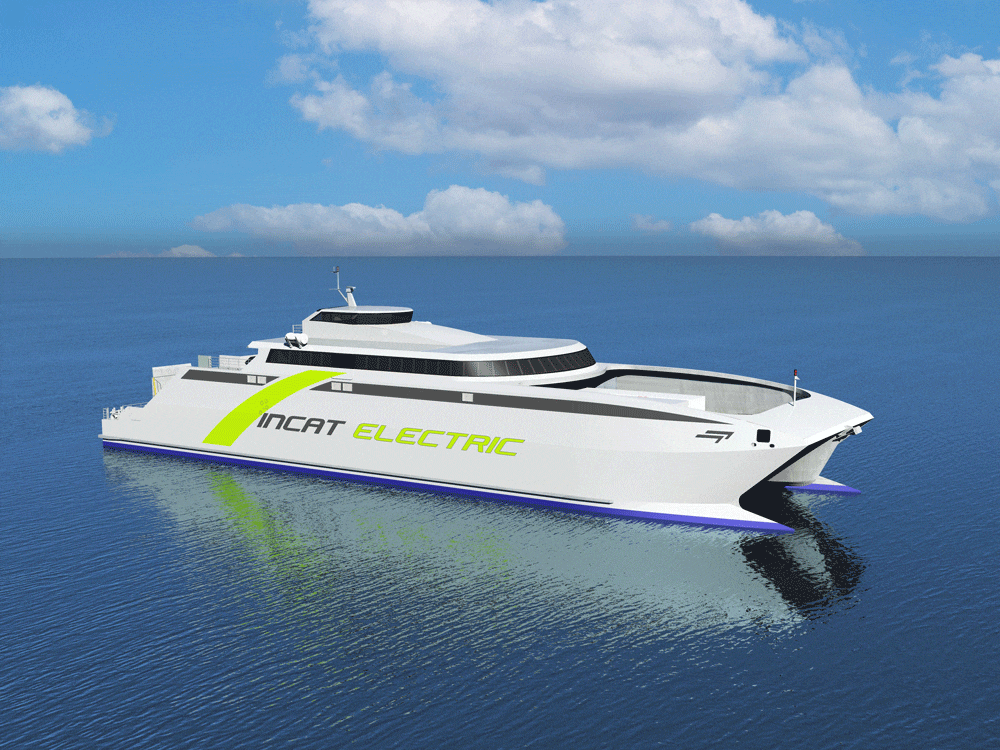Incat Tasmania has taken inspiration from the skies, having unveiled plans to “do for short sea-sea ferry services what Boeing did for the aviation industry” with a new range of electric ferries. And, just as Boeing reduced its development and manufacturing costs by incorporating standardised components and processes, so Incat predicts that the new e-ferry range will “make zero-emission vessels more readily available”, comments the boatbuilder’s founder, Robert Clifford.
“Boeing was able to do it with aircraft over the last 100 years, and we are working on an expansion plan to enable the Incat shipyard to produce multiple battery-electric vessels each year,” Clifford highlights. “We are offering the global ferry market options for series-produced vessels both small and large, just like Boeing did with the mass-produced 737 and Airbus did with the larger Airbus 380: you can play around with the seating and toilet arrangements, but you don’t change the wings.”
Set to initially target European ferry operators before honing in on Asia, Incat makes no bones about its desire to establish itself as a leading global producer of efficient electric ferries. “To reduce emissions in line with ambitions around the world, hundreds – if not thousands – of zero-[direct] emission ships need to be built,” the company comments. “Battery-electric propulsion, coupled with lightweight aluminium-constructed ships on shorter sea routes, will be the ideal choice to cut emissions.”
Incat’s e-ferry production plan will see the group roll out multiple 70m vessels, plus one larger, 140m+ newbuild, from its Hobart facility each year – built to hullform specs developed jointly by Incat and Revolution Design. Clifford tells Ship & Boat International: “The shipyard has two large construction halls with dry docks and a third construction hall with a launch area: hence, we can build multiple vessels simultaneously.” At present, the yard’s largest dry dock, Wilsons, is working on a 130m version of the e-ferry for South American operator Buquebus, with delivery slated for 2025. Meanwhile, the facility’s Coverdales building hall commenced work on the first 70m electric ferry in January.
The third shed, Inches, is currently being used for the pre-fabrication of newbuild modules, and houses a training facility. Incat anticipates an initial orderbook of three electric ferries per year before orders hopefully pick up. Clifford reveals: “We have just completed building extensions which doubled the design office facility. We have also constructed a large new mezzanine level in one of the building halls, which doubles the available fit-out department floor space, and increased aluminium storage facilities, subsequently releasing more construction floor space.”
Incat also plans to double its Hobart workforce to more than 1,000 in the next few years, having welcomed 11 welders from the Philippines to its production team in 2023.
The 70m e-ferries will each feature a moulded breadth of 19.1m, a maximum deadweight of 250tonnes and the capacity to carry 450 passengers and 71 cars, or 105 truck lane metres (TLM) plus 41 cars. Incat says: “With a beam of just over 19m, [the arrangement] will reduce vessel turnaround time by allowing cars to turn on the vehicle deck and exit via the stern.” The larger, 140m+ e-ferry variants, meanwhile, are envisaged to carry up to 2,000 passengers.
As part of the group’s standardisation strategy, the e-ferries will be kept simple in terms of design, and made as lightweight as possible. “Once the weight is under control, we start to see efficiency gains in energy consumption, which make these vessels a viable option for high-speed, short-range routes,” says Clifford. “For those customers who want to travel longer distances, the lightweight design concept can be extended to include larger vessel designs that operate at lower speeds but can carry more cargo load, thus maintaining high overall transport efficiency.”
A typical diesel-powered ferry, Clifford suggests, might notch up “400tonnes for the engines; 100tonnes for the gears and gearboxes; 100tonnes for the fuel tanks; and 100tonnes for the fuel itself”. Replacing these requirements with a 250tonne battery pack, he adds, slashes the vessel’s weight by nearly two-thirds.
The batteries will be located in the e-ferries’ catamaran hulls. It’s likely that a diesel genset would also be installed, to provide back-up in the event of an emergency. The powertrain includes fixed-pitch propellers driven by permanent magnet motors, all based on a DC electrical propulsion system. At the time of writing, a supplier for the ferries’ batteries was still to be confirmed, though Clifford comments: “We have several suppliers to choose from for marine-grade battery systems in the multi-MWh range.” Incat intends the vessels to be capable of 25knots at 150dwt, with sufficient range for six daily trips, including the ability to complete a 20nm route at 25knots and a 90nm route at 12knots (based on the use of a 5,900kWh energy storage system, with charging scheduled for both ends of the journey).
Depending on in-harbour charging facilities, it would take approximately 30-45 minutes to recharge the 70m ferry between trips, Incat estimates.






